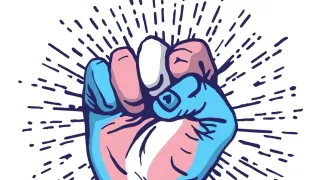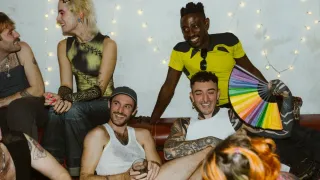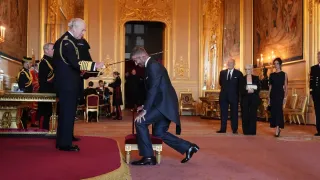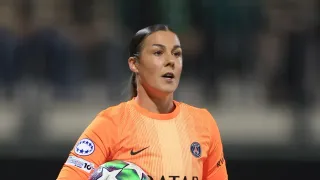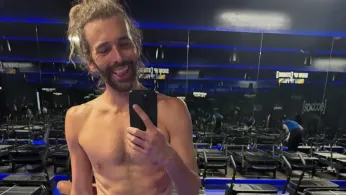
6 hours ago
Jonathan Van Ness Isn’t Putting His Shirt Back On: Queer Eye Star Sparks Lively Debate on Body Positivity, GLP-1s, and Self-Love
READ TIME: 4 MIN.
There are few things gayer—and more glorious—than a Jonathan Van Ness video. Whether they’re flipping their hair on “Queer Eye,” dazzling audiences with Olympic-level gymnastics, or just living out loud on TikTok, Van Ness has become a beacon of radical joy and unapologetic self-acceptance for queer folks everywhere. So when JVN recently revealed a dramatic 70-pound weight loss, it wasn’t just a personal milestone—it was a cultural flashpoint. The internet, predictably, had thoughts.
But in quintessential JVN fashion, they’re not shrinking from the conversation. Instead, they’re flipping the script, topless and triumphant, sparking a fresh debate on what body positivity, neutrality, and queer self-love really mean in an era of GLP-1s and Instagram scrutiny .
Let’s get this out of the way: Van Ness’s weight loss isn’t just about shifting numbers on a scale. It’s about health scares, medical decisions, and a renewed relationship with their body. In a candid TikTok, Van Ness revealed that a “medical issue” in 2023 led to a colonoscopy and, when answers were elusive, they turned to a GLP-1 medication—a class of drugs originally developed for diabetes but now famously used for weight management .
“There's a whole gigantic conversation around,'Oh you were a big body positive person so you're not a body positive person anymore,’” Van Ness explained, voice earnest yet unbowed. “What do you mean? I'm all about body neutrality. The way that you look does not define your worth, doesn't define your lovableness. You are worth love and worth celebration, no matter what your body looks like” .
For Van Ness, the journey wasn’t about shedding shame, but about feeling good—inside and out. “I was always really cute, and I always felt cute. But I just didn’t feel good, and now I feel good,” they shared, summing up the ethos that’s endeared them to so many in the LGBTQ+ family .
The ripple effects of JVN’s announcement go far beyond the comment section. For many queer people, particularly those whose bodies have been policed, pathologized, or politicized, the question of weight—and who gets to talk about it—carries extra weight. The rise of GLP-1 medications (like Ozempic) as celebrity-endorsed weight loss tools has ignited fierce debates: Is this empowerment, or a new kind of pressure?
Van Ness doesn’t shy away from the complexity. “I have always felt confident and beautiful in my body, no matter what size I was,” they asserted, showing before-and-after photos as proof that confidence isn’t a number or a before/after binary .
But they’re also transparent about the role of mental health. In January, Van Ness said the medication was helping them treat an eating disorder: “This time in my life, I knew that I needed a little bit of extra help. With everything I’ve been through publicly and privately in the last couple years, I gained quite a bit of weight, wasn’t feeling good” .
Such honesty is rare, especially amid the airbrushed perfection of influencer culture. For LGBTQ+ audiences, who have so often been told their bodies are “too much” or “not enough,” Van Ness’s message is both radical and reassuring: You can change your body without changing your worth.
Here’s the tea: The LGBTQ+ community has always been at the vanguard of body politics. From voguing ballrooms to Pride parades, queer people have redefined beauty and worth on their own terms. Yet, as body positivity went mainstream, it sometimes lost its radical edge—flattened into hashtags and corporate campaigns.
Enter body neutrality, Van Ness’s rallying cry. The idea? Your body is not a billboard for your value, activism, or self-love. You can celebrate it, change it, or just exist in it, and none of that makes you more (or less) lovable.
“Everyone is worthy of love and worthy of celebrating—no matter what they look like,” they remind us . For queer folks—especially transgender people, nonbinary individuals, and anyone whose body blurs the lines—this is a lifeline in a culture that still polices gender and size.
Van Ness’s topless TikToks aren’t just thirst traps (though, let’s be real, they’re that too). They’re a reclamation of queer joy, a refusal to let anyone else write the story of their body. “I feel like a f***ing minx right now… When I’m 80, I want to see pictures of me when I was in my 30s looking cute. So, that’s why the top’s off, because I feel really cute,” they quipped, delivering the kind of quotable moment only JVN can .
The conversation Van Ness started isn’t just about celebrity transformation—it’s about the ongoing, messy, gorgeous work of loving ourselves and each other, especially in queer spaces. It’s about recognizing that health is personal, that bodies are political, and that joy is not reserved for the thin, the “fit,” or the Instagrammable.
As the LGBTQ+ community continues to push for more nuanced, inclusive conversations about body image, mental health, and autonomy, Van Ness’s journey is a reminder: Our bodies are ours. Our stories are ours. And whether we’re taking our shirts off on TikTok or just surviving another day in a world that polices queer bodies, we are, as JVN says, “worthy of love and celebration.”
So if you see Van Ness flexing those hard-earned abs—or just serving their signature sparkle—remember: it’s not about the weight. It’s about the freedom to be seen, celebrated, and loved, in every body, at every stage.
